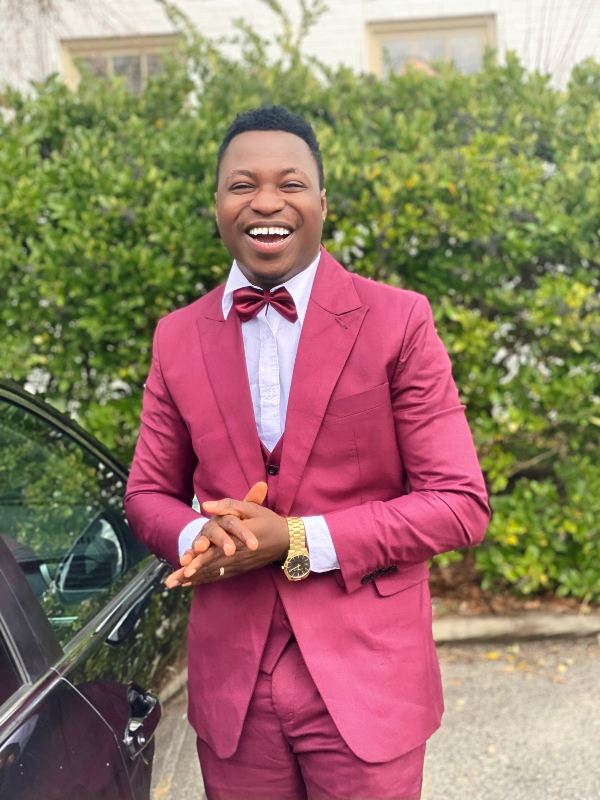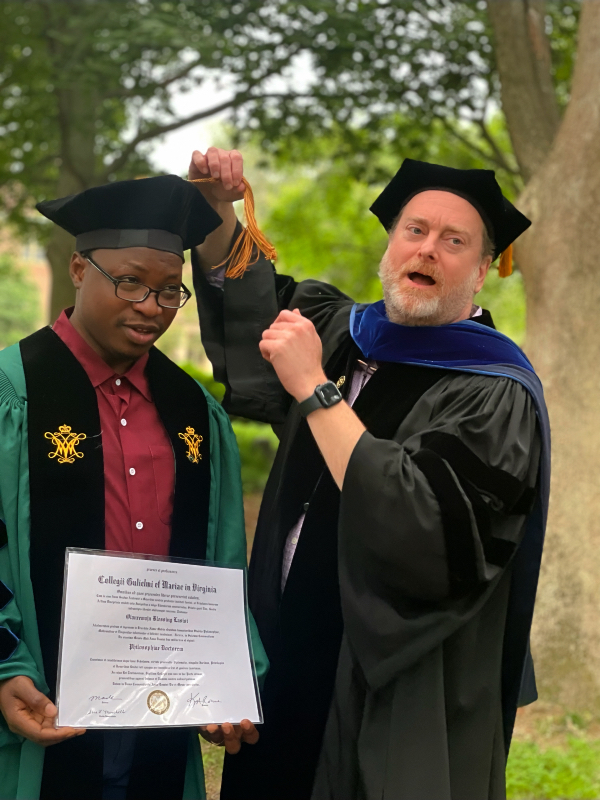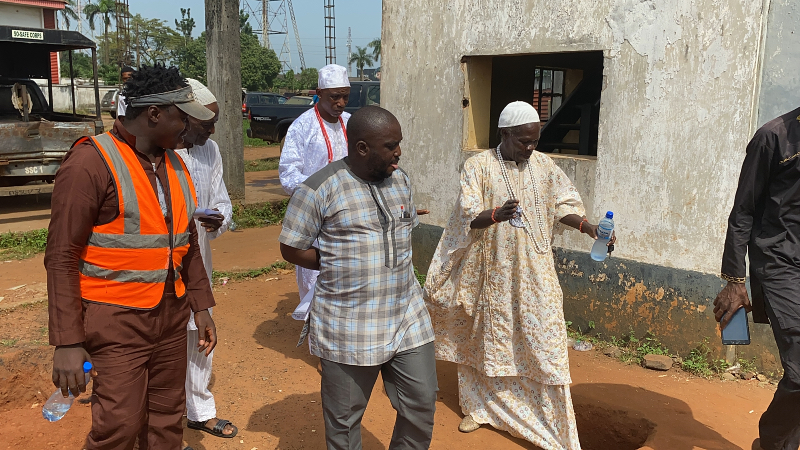Recent William & Mary Anthropology Graduate Dr. Olanrewaju Lasisi Obtains Postdoctoral Fellowship at the University of Virginia and Assistant Professor Position at the Ohio State University

Dr. Olanrewaju Lasisi, who this year completed his Ph.D. research at William & Mary’s Anthropology Department, has recently achieved a string of prestigious academic achievements. As well as successfully defending his Ph.D. entitled “Landscapes of Power: A Historical Archeology and Cultural Astronomy of Ìjẹ̀bú-Yorùbá Palatial Urbanscapes, AD1000-1900” (which won William & Mary’s Distinguished Dissertation Award), Olanrewaju has successfully obtained a Mellon Postdoctoral Fellowship at the University of Virginia’s School of Architecture, a Wenner-Gren Post-PhD Research Grant, and appointment as an Assistant Professor of Anthropology (tenure-track) at the Ohio State University starting in 2024. Olanrewaju sat down with Tomos Evans, his friend, colleague, and collaborator on the Ife-Sungbo Archaeological Project, to talk about his inspiring story, and discuss his future research trajectory under these new opportunities.
Olanrewaju began by discussing the blossoming of his early interest in archaeology and history as a student in southwest Nigeria:
“When I was a young boy in primary [elementary] school, we took classes in social studies. When being taught about evolution, I asked the teacher “What do you mean by Homo sapiens, to which she responded “I don’t know, I’m not an archaeologist!”. This led me to ask the question in my mind – well what is an archaeologist?”
Olanrewaju’s early curiosity drove him to learn more about the discipline, and he came to appreciate the notion of studying the past through its material remains, especially when coming face-to-face with early material culture in his native Ìjẹ̀bú-Òde, originally by chance:
“I loved the whole concept of who an archaeologist could be. Many years later, when I was a teenager, I was working at a construction site, where I was mixing cement and sand together. At the first brush of the soil, I saw pottery fragments.” Olanrewaju was struck by the immediate question: “Who used and dumped these pottery fragments? This was in the middle of nowhere, with no houses around.”
Struck by an intense curiosity when encountering the artefacts of past Ìjẹ̀bú people, it was then that Olanrewaju decided that he was interested in developing a career as an archaeologist. Olanrewaju then applied to pursue a degree in Archaeology at the University of Ibadan (UI). UI has a prestigious place in the history of Nigerian and African archaeology, having trained generations of famous pioneering Nigerian archaeologists, including Bassey Andah, Caleb Folorunso, David Aleru, David Aremu, and Akin Ogundiran, among many others, who have all contributed to a robust infrastructure for academic archaeology in Nigeria and in the diaspora. Olanrewaju has fond memories of his studies at the university:
“It’s all memorable I will say – the people, the environment of the university itself – but my most memorable experience and time at Ibadan was all of the fieldwork I attended there. At Ibadan you have to go to a field school in your second year, third year, and fourth year.”
Olanrewaju appreciated the friendship, community, and camaraderie that these field schools (in 2012, 2013, and 2014 respectively) fostered among him and his fellow undergraduates: “You’re all sharing the same bus, living under the same roof, going to the site at 7am every morning.” From an academic standpoint these field schools, which occur across southwestern Nigeria, gave Olanrewaju opportunities to observe archaeological contexts often very different from those he had observed in Ìjẹ̀bú, thus giving him a broad comparative perspective on the archaeology of the Yorùbá-speaking region, and beyond. The field schools also provided invaluable practical experience, which molded Olanrewaju into a rigorous and methodical field archaeologist. Olanrewaju especially appreciated the mentorship of the university’s professors in the field:
“My interaction with the professors at the University of Ibadan was so helpful at the time – and even until now – but my interaction with them in the field was surreal: it made me realize that “this was exactly why I came to Ibadan!” The field itself was where I could truly learn how it’s done.”
As well as these field schools, Olanrewaju undertook his own fieldwork in 2014 in collaboration with his undergraduate advisor David Aremu, back in his homeland of Ìjẹ̀bú. It was here that he came face-to-face with the archaeology of Sungbo’s Eredo – a mighty bank-and-trench earthwork, 100-miles in its circumference, surrounding a portion of the Ìjẹ̀bú Kingdom, which has been speculated to be Africa’s largest single anthropogenic structure.
“He [Professor Aremu] took me to the site, dropped me off, and he said “Go and excavate there”, and he left and called me to say “I am now in Ibadan, tell me what’s going on!” He gave me a sense of independence, and also the ability to do independent research, and in supervising the work, and working with the local people.”
Professor Aremu would also invite Olanrewaju to co-publish on their combined work at the Oke-Eri site at Sungbo’s Eredo, which was an important boost to his budding career as an archaeologist. It was then that Olanrewaju began to consider studying abroad for his intended graduate research on the archaeology of Ìjẹ̀bú, and it was during this year that he met Professor Gérard Chouin (Professor at William & Mary’s History Department) who was coming to Nigeria for research for the first time (in 2015). Professor Chouin, in collaboration with Professor Adisa Ogunfolakan (Obafemi Awolowo University, Ilé-Ifè) had recently formed the Ife-Sungbo Archaeological Project, a collaborative international effort to research and document more of the archaeology of the sacred Yorùbá city of Ilé-Ifè, and of Sungbo’s Eredo:
“I had started thinking about doing collaborative work with scholars from abroad on the archaeology of Nigeria, and so in 2014 I reached out to Gérard while I was working at Sungbo’s Eredo, as I knew about his research on the earthworks in Ghana. I reached out to him to tell him about my findings, and we talked a lot – we always had a back-and-forth conversation.”
It was through these conversations that Olanrewaju learned about Professor Chouin’s upcoming fieldwork in Nigeria, which he ended up joining in 2015, 2016, and 2017. Professor Chouin encouraged Olanrewaju to apply for Ph.D. research in the US – at William and Mary and elsewhere. “I chose William & Mary due to the bond I have with Gérard, and the fact that we had decided to collaborate while In Nigeria. I don’t regret the decision!” At this time, Olanrewaju also met his advisor in the Anthropology Department, Professor Neil Norman, whose kindness, and research on West African earthworks, also inspired him. With this expertise, it can be said quite fairly that William & Mary is one of the best universities for studying the archaeology of West Africa (such as of the Yorùbá, Fon, and Akan peoples), especially when it comes to its myriad earthworks – the most permanent and lasting examples of historic architecture in the region.

Having discussed Olanrewaju’s early background and journey as an archaeologist, Tomos then quizzed Olanrewaju on some of the recently defended research that he undertook throughout his Ph.D. Olanrewaju began by first giving an overview of the Ìjẹ̀bú Kingdom, now part of southwestern Nigeria, and its historical importance. The polity is known to have been around since at least the 15th century AD, when it was first documented by Portuguese traveler Duarte Pacheco Pereira:
“The kingdom played a very important role as a nexus between the Atlantic Ocean and the Yorùbá interior during the second half of the second millennium AD. During the Atlantic trade, they were the middlemen of the Yorùbá Atlantic.”
He highlighted that there is a dearth of archaeological evidence for the kingdom, due to a relative lack of research in the region:
“The problem is not that there are no material remains to help us understand the Ìjẹ̀bú past. We have not looked much at the archaeology of the place, but also, we have not used the right methods to do the archaeology. That is why in my work I focus a lot on indigenous ontology and hermeneutics – not only as a way of doing, but also as a way of knowing the Ìjẹ̀bú and Yorùbá past. This ontological turn is important for us to begin to delve into new areas of research among the Yorùbá.”
The kingdom during this period accomplished many impressive technological feats, in astronomy, agriculture, trade, political organization, and architecture, and Olanrewaju believes strongly that we have only begun to scratch the surface in terms of what there is to learn about the Ìjẹ̀bú past.
For his Ph.D. research, Olanrewaju sought to contribute to fleshing out our understanding of this past via a multidisciplinary approach. He focused on questions pertaining to archaeoastronomy and the urban and ritualized landscape in the Ìjẹ̀bú Kingdom and performed excavations at the traditional capital of the kingdom: Ìjẹ̀bú-Òde, focusing on its interior earthwork and palace complex. As well as Sungbo’s Eredo, there are additional, smaller earthworks surrounding the town of Ìjẹ̀bú-Òde, and Olanrewaju was interested in better understanding the relationship between the town, its palace (a microcosm of the wider Ìjẹ̀bú landscape of power), and that of the broader kingdom, including the Eredo. It was during this fieldwork that Olanrewaju realized the importance of ritual practice in studying and understanding these aspects, especially in a historical context where ritual, oral tradition, and forms of material culture helped carry history in the absence of written records:
“They wrote by encoding their knowledge system in oral poetries, in place names – and all of this is connected to the practice of rituals. So if you need to ask questions about the past here, look into the ritual practices. Some may state “Why should we deal with ritual practices? We are talking 700 years and you are looking at the present!” – I know that, but at the same time, ritual practices are sacrosanct. They maintain a legacy of timeless relevance – it becomes tradition. So much that sometimes the people performing the rituals don’t know why they are doing it, but they do it because it’s a tradition. This allows us as archaeologists to study traditions, and bring out the facts from them.”
Festivals became a means of marking time and generating meaning for these communities. Of particular importance to Olanrewaju’s work is the Agemo festival, which occurs in July. To calculate when the festival will be, a date nine days before it is marked: June 21st, which coincides with the summer solstice when the sun is in the northern part of the Yorùbá sky:
“So before the introduction of the Gregorian Calendar, they had their own ritual calendars. And for you to have this ritual calendar, you need to have knowledge of astronomy. So ritual is very important to inform us about astronomy – there can be no ritual without looking at the heavens!”
The solstices and the equinox thus coincide with important ritual events that were considered important to the wellbeing and longevity of the kingdom. Olanrewaju is interested in these rituals as a source of history, especially in how it interacts with landscape:
“Ritual movements are not merely something random upon the landscape, in fact ritual movements are by themselves more permanent than standing architecture. They believe that they must move in a particular way, and this is the architecture of ritual movement.”
The tracing of these – notably the movements of the Agemo festival – has helped shape Olanrewaju’s approach as an archaeologist as he focused on excavating important loci in these ritual movements which yielded significant artefactual discoveries. During this festival, the Agemo priests, who all live in the Agemo towns near Ìjẹ̀bú-Òde, and Sungbo’s Eredo, gather in the town’s palace complex where they move in highly structured ways. They must enter through the correct gates so as to avoid upsetting the cosmic balance, but for Olanrewaju there are also deeper historical reasons for these specific pathways. For instance, particular loci where the Agemo priests would perform rituals before entering the town appear to correspond to the original gateways of the town’s enclosure, which no longer exist. Though the gates themselves are long gone, the liminal rituals of entry – ijuba – must still be performed.
“Through rituals, we are able to see architecture that is unseen. You are able to imagine what was there.” At the place where the Agemo priests dance, Olanrewaju uncovered a potsherd pavement which he argues represents the effigy of the Agemo high deity. Olanrewaju has become a strong advocate for the close integration of archaeology with the study of ritual movement:
“Looking at ritual practices is the right step for doing the archaeology of the Yorùbá, and actually, in Africa more broadly where, as has been argued by Kenyan philosopher John Mbiti, everything is connected to religion.”

Towards the end of the conversation, Tomos discussed with Olanrewaju some of his future plans – what directions he will take his research in moving forwards as he undertakes these new opportunities with Wenner-Gren, UVA, and the Ohio State University:
“Everything seems aligned to where I am in my development as a scholar – in thinking about archaeoastronomy, in thinking about rituals, and also how these connect to architecture.”
At UVA’s School of Architecture, Olanrewaju plans to continue his emphasis on the ways in which architecture that is no longer extant or visible can maintain permanence through ritual, sometimes even greater than that of visible forms:
“I want to work on publications connecting archaeoastronomy and the architecture of ritual movement. This will help allow scholars of African archaeology to employ these as methods to do archaeology. As well as publishing my discoveries, my aim is to develop and encourage new methods to guide other scholars, and help them produce more finds – the movements of gods don’t lie!”
In undertaking this work at UVA, he also relishes the opportunity to engage with scholars of other disciplines – architects, landscape architects, landscape historians, archaeologists, anthropologists, religious studies scholars, and geographers. As an African scholar, Olanrewaju aims to draw attention to the fact that there are still ways of undertaking archaeoastronomical study of structures (their alignments, associations with the sky etc.) even where architecture has disintegrated: through the study of the alignments of ritual movement. At the Ohio State University’s Anthropology Department, Olanrewaju plans to carry these ideas further, and transcend disciplinary boundaries by centering indigenous knowledge in his analysis of the past:
“My aim is to be a scholar who promotes indigenous hermeneutics and ontology. I want to help us decipher what we have overlooked. Indigenous hermeneutics is a body of knowledge in itself, and the central theme of my work is promoting indigenous hermeneutics as a way of knowing the past.”
William & Mary Anthropology celebrates Olanrewaju’s wonderful success in defending his Ph.D., obtaining the Wenner-Gren grant, and achieving these prestigious positions at UVA and Ohio University. Well done, and it is most exciting to see what comes next!














